Rhawn Gabriel Joseph, Ph.D.
BrainMind.com
BEFORE BABYLON: THE UNIVERSAL LANGUAGE
Certain gestures and facial expressions appear to be innate and natural in origin and are understood across cultures (Critchley, 1971; Eible-Eisbesfeldt, 1995). Regardless of culture, people smile the same, and when smiling people often raise the eyebrows and may nod the nead which appears to be a universal greeting gesture (Eible-Eisbesfeldt, 1995). Smiling and nodding at members of the opposite sex may also be seen as flirtatious. Other common cross-cultural gestures include the balled fist, flexed arm, furrowed brow, open mouthed or tight lipped expression and this appears to be true of ape or human.
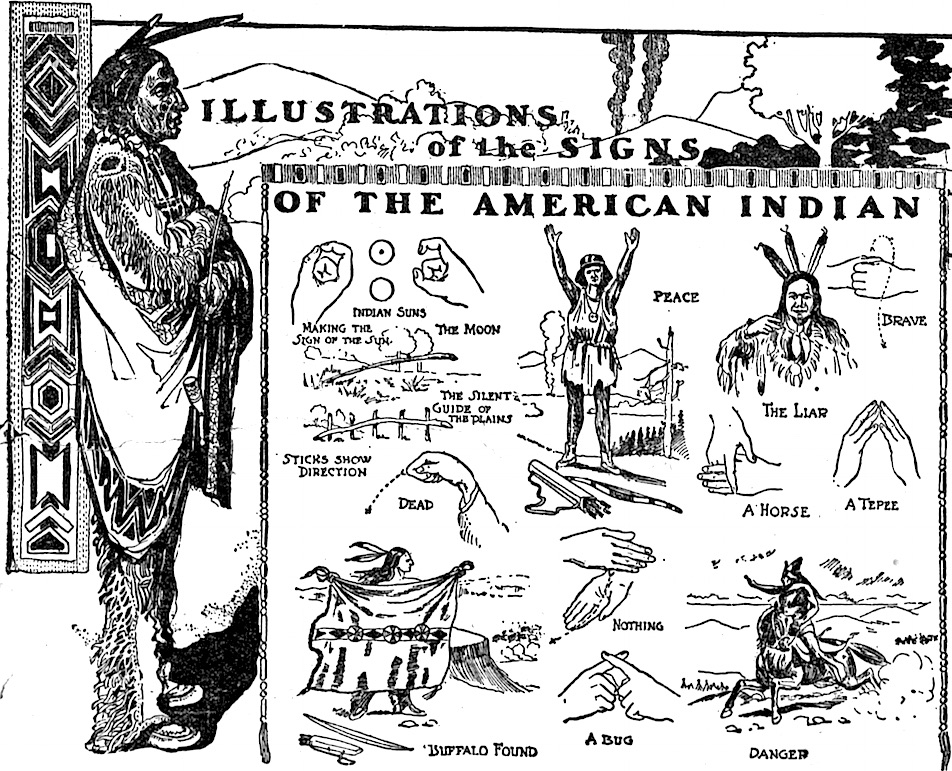
Facial expressions indicative of puzzlement, doubt, contempt, anxiety, insecurity, or haughtiness are also easily understood between most cultures. Many gestures in fact circumvent language and illuminate or make unnecessary an exchange of dialogue; e.g. blowing a kiss, shaking hands, kissing on the cheek. In fact, certain gestures convey meaning that are very hard to put into words, such as demonstrating versus explaining how a corkscrew works and what it is shaped like.
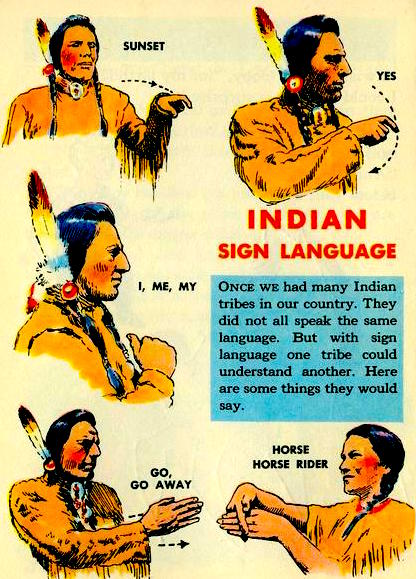
These latter signs, are in part learned, although again they may be understood across cultures. Yet other gestures and facial expressions, such as smiling, are innate. It is because certain gestures are innate, that the human infant, like the human adult and other primates, is capable of communicating likes, dislikes, desires, and other emotional states, non-verbally. Children are said to employ over 150 natural gestures and signs, many of which they unlearn or modify as they grow older (Critchley, 1971).
MacDonald Critchley (1971), described a number of "deaf and dumb" children from France, Austria, Czechoslovakia, and Italy with no formal training in sign language or lip reading who were temporarily gathered together at a special school for a weekend. Critchley noted that within an hour or two they were all communicating freely with each other, and understanding each other almost completely via the use of natural signs and facial expressions.
Similarly, among the American Indians, although over 65 linguistic families were still in existence by the mid 1800s, even those who lived thousands of miles away and spoke a completely different dialect had little difficulty communicating via the use of natural and imitative signs. For example, to indicate snow or rain they might hold their palms up and then slowly wiggle their fingers as they dropped their hands. To indicate cold, they might clench both fists then fold then against the chest followed by a trembling motion. Via gesture and the use of natural and immitative signs complete and detailed conversations could be held between individuals who knew nothing of the other's native tongue.
Natural (biologically rooted) signs are first and foremost rooted in emotional displays and thus have common limbic origins (chapter 13, 14, 16). However, many gestures, although originally natural, also come to be shaped by the cultural and social environment in which one is raised. Natural signs and gestures, like spoken language, are subject to modification, and abbreviation or they become stylized to various degrees as they become part of a common currency of exchange (Critchley, 1971; Kendon, 1986; Kima & Bellugi, 1979).
For example, in a military culture, the open (empty, non-threatening) hand above the eyes (which decreases the threating nature of direct visual contact) has become a military salute. Just as dialects and languages have evolved from common roots, many gestures have also differentially evolved so as to form distinct gestural languages as well.
Natural and learned signed (as contrasted with, for example, "sign language") do not possess the "deep structure" grammatical organization that supposedly typifies spoken language. Natural signs are aggramatical and do not require the same neuroanatomical structure as does language for expression (Joseph, 1993). In contrast, formal gestural systems such as American Sign Language are grammatically complex (Kima & Bellugi, 1979; Werner & Kaplan, 1963) and are dependent on the same neuroanatomical structure that subserves language, especially Broca's area and the parietal lobule, the angular gyrus in particular (Joseph, 1993). As detailed in chapter 20, the parietal lobe is a "lobe of the hand" and the functional integrity of this structure, the inferior parietal lobe (IPL) in particular, is essential for the learning and production of formal gestural systems.
The inferior parietal lobe, however, is exceedingly slow to mature, and in fact is the slowest of all brain regions to myelinate and functionally develop (Conel, 1937-1963; Fleschig, 1901; Joseph et al., 1984) --ontogeny thus paralleling phylogeny. Because of its slow rate of maturation children will produce "natural" signs well before they can learn formal gestural systems, just as children at first learn to read and then later, read to learn--reading being dependent on the functional integrity of the IPL (see below).

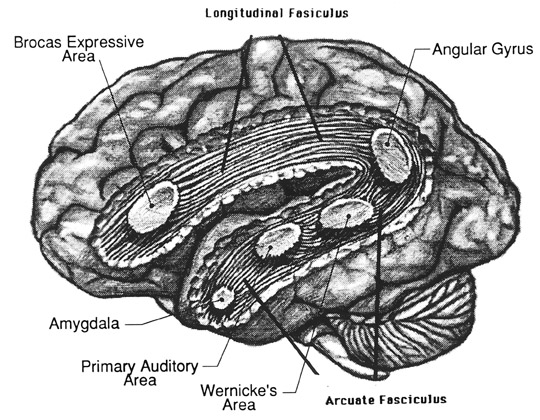
THE ONTOGENY OF GESTURAL LANGUAGE
Because of the immaturity of the forebrain (see chapters 23-26), neonates are incapable of gesturing, and even their "smiles" are little more than slight muscular movements at the corner of the mouth--and are not truly smiles (Sroufe, 1996). Infantile movements themselves are initially very global, sprawling, and unfocused, involving the entire body musculature or at a minimum body parts irrelevant to the action being explored. It is only as the infant and the forebrain ages and matures that movements become more distinct and specific such that bodily gestures eventually become increasingly localized to the arms, hands and face (Piaget, 1952, 1962, 1974; Werner & Kaplan, 1963). As the infant and its nervous system mature its repertoire of movement patterns expands but also becomes modified for the purposes of interacting with the environment and grasping some desired object. Many movements and gestures in fact, come to be associated with the use of certain objects, tools, toys, and utensils.
With the rapid differentiation of the limbic system and the right brain mental system, not just movements but emotions come to be more refined, specific, and less global as the child ages (see chapters 15, 25, 26). Now specific emotional states are experienced and these in turn come to be expressed via global and then later specific movements as the infant screams, babbles, cries or coos. Soon the lips and vocal tract also comes to be specifically shaped so that certain words are formed.

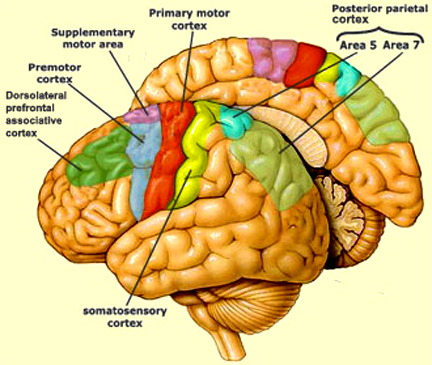
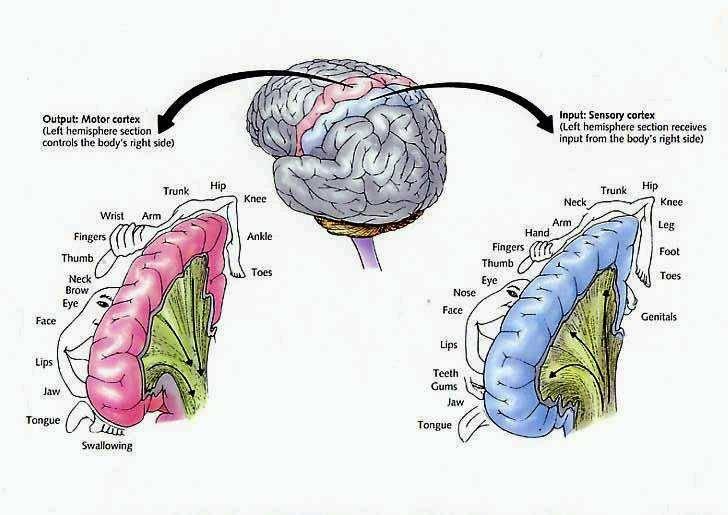
With the maturation of the frontal-parietal somatomotor areas--around 8-12 months of age (chapters 24, 25), movements become more precise. After age one movements increasingly receive a temporal-sequential stamp, and thus begin to be performed in the same manner as they are repeated endlessly. Finally these movements become stylized and habitual as they are repeatedly relied upon to perform certain tasks (Werner & Kaplan, 1963).
Once certain movements are associated with certain objects or tasks, the child is then able to use gestural mimicry as a form of communication. They can pretend to use an imaginary tool or drink from an imaginary cup. However, insofar as these gestures are limited to mimicry and pantomime, they are thus intermediate between natural gestures and depictive gestures including what is recognized as sign language (Werner & Kaplan, 1963).
Over time there is increasing differentiation such that innate and imitative gestures become more and more spatially and temporally distinct from that which it is representing and thus less and less naturalistic. That is, gestures and movements become increasingly distinct from their biological roots.
THE ONTOGENY OF IMITATIVE GESTURES
Human beings sometimes use imitative gestures when painting and drawing, when pretending, playing, mocking or story telling, as well as when attempting to describe. This is a capacity that is not only informative and amusing, but which is also fairly unique to apes, monkeys and humans.

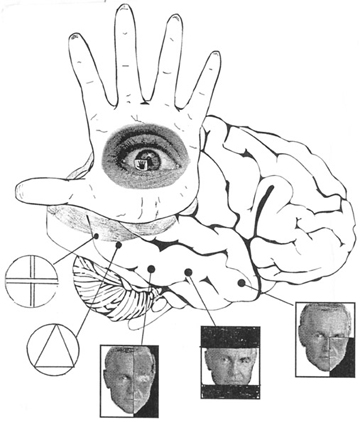

Children begin to make imitative moments well before the age of one (Piaget, 1952, 1962, 1974; Werner & Kaplan, 1963). However, because of their poor motor control they may mimic with the wrong muscle groups. For example, they may open and close their mouth when mommy is blinking her eyes. To merely imitate, however, communicates very little and may in fact communicate nothing at all.
True depictive movements and gestures do not begin to appear until between the ages of 2-3. At this age children can use gestures to indicate and depict size, form, and function, and then later, objects, animals, and activities (Piaget, 1952, 1962, 1974; Werner & Kaplan, 1963). Again, although children employ natural gestures, as they age they increasingly employ mimicry as well, even when indicating objects and animals and activities. For instance, a child may pretend to drink from a cup, and later they may depict a flickering light bulb by rapidly blinking their eyes, or they may make stirring motions with their finger to indicate a spoon, or they may outline the shape of the item or object via hand movements in the air.
As children increasingly refine their ability to imitate particular patterns of movements they are also able increasingly to separate the signs and gestures they use from the objects they are trying to depict. In the early stages of imitation they pretend to drink out of a cup that actually contains milk or water. Then, as they age, they pretend to drink out of an empty cup, and later still they can pretend to drink in the absence of a cup and can use body language to indicate swallowing and consumption, e.g., smacking the lips.
Consider the use of a scissors which can be indicated by bumping the thumb and forefinger together as if one were holding and cutting with it. Or cutting with a scissors can be indicated by the index and middle finger, such as by snapping them together as if cutting. However, as pointed out by Werner and Kaplan, in the latter instance, the movements are functional and more reality oriented so as to serve the purpose of imitating events and activities of every day life (Piaget, 1952, 1962, 1974; Werner & Kaplan, 1963).
To recapitulate: Initially the infant/child will use the object in order to mimic an activity, but they cannot mimic the object or activity without the object. If an adult demonstrated similar limitations in gesture, this condition would be referred to as "apraxia" and the possibility of an lesion involving the IPL would be entertained. The child is not "apraxic" per se, however. Rather, the IPL is exceedingly immature.
As the child ages, they learn to substitute a body part for the missing object. They may use the entire hand to indicate hammering with a hammer, as if the hand were the hammer instead of pretending to hold a hammer. Or they might use their index finger to indicate a key, rather than their thumb and index finger as if holding a key and inserting it into a lock. An adult who behaved similarly would still be considered "apraxic." Nevertheless, although the child or adult uses the body-as-object, these imitative acts involve the repetition of the exact motor sequence which makes up the normal behavioral act. However, because of IPL immaturity, especially of the angular gyrus, the child cannot pretend to actually use an imaginary object unless they substitute a body part for the object.
Likewise, it is because of IPL immaturity that although a two or three year old can hold crayon or pencil in order to color or shade in an object, they cannot independently draw the object. Similarly, although they can scribble, they cannot write. Drawing objects and writing are dependent on the functional integrity of widespread areas of the neocortex, the IPL in particular (see below and chapter 10) and the left IPL appears to mature more slowly than the right--at least in boys--which is why the capacity to draw begins to emerge in advance of the ability to write. Writing, in fact, evolved from picture making, and both are dependent on the IPL (see chapter 6 and 10).
GESTURE & CHILDREN'S SPEECH
The ability to produce gestures is also associated with the ability to comprehend gestures, just as the ability to write or to draw pictures is associated with the ability to comprehend written language or visual symbols. As noted, whereas natural gestures are independent of speech and do not require the language areas for production or comprehension, the same is not true of mimicry/pantomime (Rothi, et al., 1986) and the formal use of signs, i.e. sign language. This is why gestures often accompany speech, especially gestures involving the right hand.
Nevertheless, because formal gestures are an outgrowth of natural gestures, and as natural gestures are independent of language, initially, gestural mimicry emerges in advance of language. Moreover, because of the immaturity of the axonal fiber pathways (the arcuate fasciculus) which links the IPL with Broca's expressive speech area (see chapters 15, 24, 25), children are unable to verbally describe what they are going to imitate until after they have completed the gesture.
For example, a 3 or 4 year old will pantomime the use of a hammer and will then explain or name what they have done. An 6 or 7 year old will pantomime while he is explaining what he is doing, whereas a 9 or 10 year old can state what they are going to mimic and then use the appropriate gestures. Hence, first language follows gestures, then accompanies gestures, then precedes as well as accompanies and follows gestures, such that by time the child reaches 12 years of age they can use gesture selectively and employ gestures in relationship to certain words so as to emphasize those words. Therefore, it is only at this later age that the two systems of communication are coordinated (Werner & Kaplan, 1963). Hence, with increasing age, gesture and speech become more closely associated and organized together, and gesture becomes more grammatical as well.
Again, this initial dissociation is due to neocortical immaturity and the fact that natural gestures are independent of language. At a later age the semi-dissociation is still due to neocortical immaturity and the inability of certain regions of the language axis to gain advance access to information regarding specific motor acts before they are performed. Hence, the child will gesture and then explain what they have done.
The progression of gestural development, that is, as gestures progress and are modified from natural/innate and becoming increasingly imitative and then depictive and then temporal-sequential and symbolic, is dependent on the maturation of the parietal lobe, the IPL/angular in particular. As the IPL/angular gyrus matures, gestural communication becomes more abstract and associated with language, and language abilities come to include reading and writing. Writing, however, is a gestural language, requiring hand movements and the gesturing with pen/pencil on paper, and/or finger gestures on a key board. It is precisely because writing/reading and gestures are linked, and in fact subserved by the same area of the brain, that injuries to the IPL disrupt the ability to produce or comprehend complex gestures/pantomime (including American Sign Language), and disrupts the ability to read and write. It is also because of the importance of this tissue, the angular gyrus in particular, that non-human animals are unable to read or write, or progress beyond simple signs in order to communicate. Athough primates, for example, have evolved an IPL, only humans are endowed with an angular gyrus--a structure which also crucial in the production of word-rich, grammatical speech.
COMMUNICATING VIA SIGNS
There once was a girl who could neither hear, nor speak, or write, nor communicate by signs. It was only through a long terrible struggle that occurred completely within her world of touch that the mind of Helen Keller's was suddenly illuminated by the world of language.
"Earlier in the day we had a tussle over the words "m-u-g" and "w-a-t-e-r." Miss Sullivan had tried to impress it upon me that "m-u-g" is mug and that "w-a-t-e-r" is water, but I persisted in confounding the two. I became impatient of her repeated attempts, and seizing my new doll, I dashed it upon the floor. I was keenly delighted when I felt the fragments at my feet. I had not loved the doll. In the still, dark world in which I lived there was no strong sentiment or tenderness....
We walked down the path to the well-house. Someone was drawing water and my teacher placed my hand under the spout. As the cool stream gushed over one hand she spelled into the other the word water, first slowly, then rapidly. I stood still, my whole attention fixed upon the motions of her fingers. Suddenly I felt a misty consciousness as of something forgotten--a thrill of returning thought; and somehow the mystery of language was revealed to me. I knew then that "w-a-t-e-r" meant the wonderful cool something that was flowing over my hand. That living word awakened my soul, gave it light, hope, joy, and set it free!...
I left the well-house eager to learn. Everything had a name, and each name gave birth to a new thought. As we returned every object which I touched seemed to quiver with life... I saw everything with the strange new sight that had come to me. On entering the door I remembered the doll... and picked up the pieces. Then my eyes filled with tears; for I realized what I had done, and for the first time I felt repentance and sorrow.
Hellen Keller (1960)
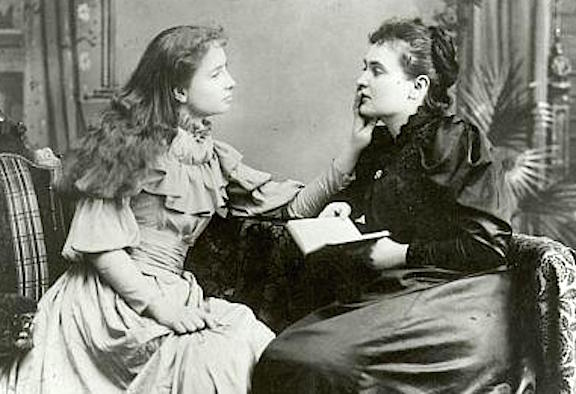
Humans have employed gestures and movements to mime and dance, to pantomime and to convey the symbolic, the sublime, the abstract, the mythical, magical, and mystical (which is why many religions utilize symbolic gestures in their rituals and liturgies) long before the development of written or complex grammatical spoken language. Gesture may have not only been a forerunner to spoken language, but provided the context in which it could develop.
Because gesture is a precursor to the development of speech, it is commonly employed by those without speech but who possess highly developed social brains. Apes, monkeys, dogs, wolves and other animals are able to gesture through eye and body movement, and facial expression and are even able to mime and dance (Joseph, 1993). Even unrelated species make some of the same gestures which essentially have the same meaning; a puppy will sometimes naturally raise it's paw as if to shake and show friendliness when confronted appropriately and apes and monkeys commonly make hand to hand contact as a signal of appeasement and friendliness. Nevertheless, their ability to learn and employ complex signs, is relatively lacking--even among species as intelligent as chimpanzees.
AMERICAN SIGN LANGUAGE & THE ACQUISITION OF TEMPORAL-SPATIAL GRAMMAR
American Sign Language (ASL) is a complex gestural language utilized by the deaf as their primary means of communicating with others. It is composed of natural as well as artificial signs which have been forged into a grammatical gestural language that is thus visual and verbal, but not auditory. However, unlike natural signs, ASL is a bit cumbersome and it takes about twice as long to indicate a word via gesture as to say it out loud.
In general, there are two structural levels to signing (Kima & Bellugi, 1979). The first level includes the rules which govern the relations between signs within sentences. The second level is concerned with the internal structure of the lexical units.
ASL makes use of space patterns and the contours of movement; i.e. hand shape, movement, and spatial location which is actively manipulated in regard to indicating syntax, nominals and verbs. For instance, nominals are assigned locations in the horizontal plane, and verb signs move among these spatial loci so as to indicate the grammatical relations between the subject and object. Moreover, the same hand shape presented in different motions or at different spatial locations, conveys different grammatical and semantic information.
Although highly grammatical and dependent on temporal contrasts, ASL is very sensitive to spatial contrasts. However, these spatial contrasts are heavily dependent on verbal described relationships such as "right" vs "left", "up" vs "down." Space and movement become subordinate to verbal labels and coordinates. Unlike gestures, be they cultural or natural in origin, ASL employs linguistic, temporal sequential, and visual referents, and thus represents a multidimensional as well as grammatical means of complex communication via movement.
Primates are able to make considerable use of their face, hands and arms for the purposes of gesturing and this has been made possible via the tremendous evolutionary development that has occurred in the parietal lobes. Thus the ability to gesture with the hands and arms as a means of communication is most developed in primates. Similarities in gestures and the brain, however, are also a function of both species being subject to similar evolutionary pressures early in their history, especially in regard to the development of the upper arm and hand, and the ability to grasp and manipulate objects. However, non-human primates, including chimpanzees, are incapable of constructing and using complex tools--which is dependent on the evolution of the angular gyrus--and thier ability to employ complex formal gestures, such as via ASL, is likewise rudimentary at best, being limited to two-word aggramatical combinations.
WASHOE
The Gardners began training Washoe in ASL in 1966. They used the method of molding the hands while he was also looking at the appropriate action or object, followed by giving him a rewarding treat (Gardner & Gardner, 1969). Given the complexity of ASL he made surprising progress.
After two years of training Washoe had learned over 30 signs which he was able to use in appropriate two word combinations. In fact, he was capable of using two word gestures before his first year of training was up, such as, "give food." Washoe picked up signs through imitation as well and was also able to correctly invent certain signs such as a gesture indicating a "bib," and made up gestural combinations to accurately describe items he had no name for. For example, for some time he mystified his caretakers by repeatedly asking for a "rock berry," which later they discovered meant a Brazil nut. He also called Alka-Seltzer a "listen drink," and a cucumber a "green banana." After three years of training he was able to use correctly over 85 signs, and after four years he had progressed to over 130 signs.
Washoe, in fact, not only learned signs and could communicate proficiently, but actively engaged in tutoring a young chimpanzee, Louis, as how to sign as well. On one occasion when a human presented a bar of chocolate, Washoe became very excited and started signing "food." However, noticing the eager and curious look of Louis, Washoe walked over and took his hand, pointed at his mouth and then molded the child's hand in the form of the appropriate sign which was then readily learned.
Nevertheless, although the efforts of the Gardners have been replicated by many others, no chimpanzee has learned to communicate beyond aggramatical two-word combinations (Temerlin, 1977).

GORILLAS & GESTURE
Gorillas are generally very peaceful creatures who maintain their massive bulk predominantly through a vegetarian diet, although they also like to eat meat on occasion, including bird eggs and termites. Like dogs and humans they are very social and roam through Central Africa in bands of up to thirty individuals which are led by a single dominant male. Their predominant mode of auditory communication is through barking, roaring, grunting, whining, whimpering, grumbling, humming, and purring. Many of their sounds, however, can convey different meanings depending on the context in which they are elicited, as well as through variations in pitch and quality. It has been estimated that their calls range from twenty to more than thirty. Often, however, their vocalizing seems to have no effect on other gorillas who may not even bother to look up (Schaller, 1963).
Another primary means of communication is through complex gestures. This includes facial expressions and a variety of postures, including chest beating, and tearing limbs from trees or waving branches in a threatening manner.
Chest beating is one of the more obvious and most easily observed gestures they employ and it usually is part of a temporal sequence of movements, calls, and actions. That is, before they beat their chest, they begin to "hoot" and will then suddenly grab some leafy vegetation and stuff it in their mouth while just as suddenly they will rise up and throw the remainder into the air. Then the chest beating occurs, the sound of which can carry up to a mile away. While so engaged they will kick their leg into the air, and then begin running sideways while they snatch a tree limb and wave it menacingly. This whole sequence is then brought to a conclusion by the gorilla holding both hands clasped together over his shoulder like a boxer who has just won his prize fight. He then slaps and thumps his hand forcefully against the ground. One could only imagine that if he held a football, he would substitute spiking for thumping.
It seems any number of events can trigger the chest thumping display, such as the presence of a human, or that of another gorilla, in response to the movement of some animal or object the identity of which they cannot completely discern, or in response to displays by other gorillas. They also engage in this display in play and in fun, or just for the heck of it. In this regard this behavioral sequence can express irritation, anger, lonesomeness or even boredom.
Another means of communicating to the group is walking in a very rigid and stiff legged fashion, moving very abruptly or lunging with the body, staring, head shaking, cowering, and even mock biting. However, what these gestures mean depends on context and the status of the gorilla who employs them.
In comparison to chimps, the tool making capabilities of the gorilla are sorely lacking. In part, this may be due to their larger, more clumsily shaped hands which reduces their ability to perform fine motor tasks. Indeed, the thumb is very small and they still use their upper extremities for knuckle walking.
Nevertheless, they frequently handle and carry objects, will construct elaborate nests for resting during the day and sleeping at night, and will tear up vegetation or yank apart tree branches as part of their display. On the other hand, those in the wild seem to lack any inclination to explore. KOKO One might assume from these observations that gorillas may not seem to be the brightest of our fellow apes. However, this may be due in part to problems inherent in the observational method. As demonstrated by Dr. Francine Patterson, gorillas possess tremendous mental powers as well as the ability to converse in depth via gesture or to even play practical jokes, such as with a plastic alligator (Patterson & Linden, 1981).
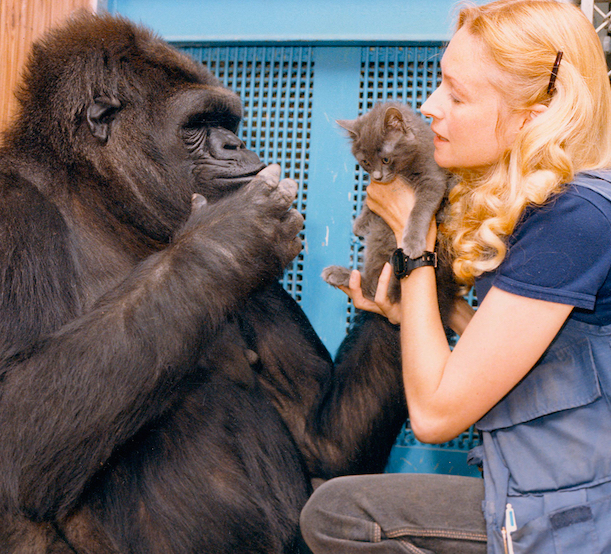
For example, Koko the gorilla apparently likes to sneak up on some (supposedly) unsuspecting human with a little toy alligator hidden behind her back. When she is near her victim, Koko will abruptly spring up, brandishing the alligator wildly. As pointed out by Dr. Patterson, it is rather amazing to think that "a gorilla might even for a moment think that it needs a prop like a toy alligator in order to scare a human" (Patterson & Linden, 1981).
Koko the gorilla began her formal training in 1972 at the age of one and for the next several years underwent a grueling full time educational regimen in ASL acquisition. This was accomplished by molding her hands to form the appropriate signs, and then by giving her a reward if she did so correctly. Before giving her a drink from her bottle, Dr. Patterson would show her the sign for drink, which is shaping the hand as if hitch hiking and placing the thumb in the mouth.
Surprisingly, Koko began to learn signs almost immediately, although admittedly they were sloppily made and often consisted of demands for food. Indeed, by her second month of training she was able to use about 16 different two word combinations. "Pour that hurry drink hurry.... me me eat... you me cookie me me... gimme drink thirsty, " and so on. Like Washoe, she invented and utilized natural signs, such as "give me" which looks like a beckoning gesture. Again this is a gesture that not only primates and humans understand, but which is comprehensible to a dog as meaning "come here."
In any case, after three years of training Koko had acquired and was regularly employing over 125 words and had utilized an additional 150. This included words such as "pillow, love, necklace, baby, hot, up down, in, out, finished, yes, no, don't, can't."
Koko could also understand many spoken words as well, and sometimes would ease drop on conversations, or answer questions that were asked out loud. For example, one day a visitor asked Dr. Patterson what might be the appropriate sign for the word "good." Before Dr. Patterson could respond, Koko made the sign for her.
Sometimes she would also demand some item, like candy, that the humans had been talking about. To keep Koko from knowing what they were discussing, these experimenters had to often resort to spelling and even then Koko figured out, for example, that c-a-n-d-y, spelled her favorite treat.
Many of Koko's comments and questions were spontaneous, and she soon learned to use words in an insulting fashion. For example, Koko did not like birds and hated the blue jays who screeched outside her window. Hence, when she dealt with someone or something she didn't like, she would call it "bird." Later she progressed to calling certain individuals "stupid devil", or "Devil head," and began using filthy language to insult Dr. Patterson or her friends, by signing at them, "dirty toilet," "stupid toilet," or "Penny dirty toilet devil."
Koko, like Washoe, also learned to combine signs to describe animals or objects, the signs for which she had not yet been taught. This includes, "barefoot head" to describe a bald man, "Giraffe bird," to describe an ostrich, "finger bracelet" to describe a ring, "eye hat" to describe a mask, and "fine animal gorilla" to describe herself. Nevertheless, like Koko and other primates who have been extensively trained in ASL, Koko could not learn to gesture in grammatical word combinations.
GRAMMAR, SIGNS, AND THE IPL
Although apes are able to sign, their ability to employ grammar even in their gestures is all but non-existant. Washoe, Koko, and other apes demonstrate no understanding of the rules of grammar. Washoe's ability to use grammatical relationships did not even approximate that of a 3 year old human child. For example, if Washoe wanted to ask to be tickled, he would sign, "tickle you, me tickle, or you tickle" as if all meant the same thing. In this regard, Washoe's understanding of grammar may be similar to that of the right hemisphere of an adult human (see chapter 10). Indeed, the human right hemisphere has great difficulty utilizing syntactial or temporal-sequential rules. For example, if the isolated right hemisphere is given a command, such as "pick up the yellow triangle and then the blue star", it may pick up the yellow star and the blue triangle (Zaidel, 1977). It responds to the first object in the sentence regardless of grammatical relationship.
Grammar is a left cerebral function, and temporal-sequencing is a fundamental property of language as demonstrated by the use of syntax and grammar. That is, syntax is a system of rules which govern the positioning of various lexical items and their interrelations to one another. This allows us to do more than merely name but to describe and to analyze how various parts and segements of speech interrelate. We can determine what comes first or last (e.g. "point to the door after you point to the window"), and what is the subject and object. When the left hemisphere is damaged, particularly the anterior portions, expressive and receptive aspects of syntactical information processing suffer.
David Premack, did provide some evidence to suggest that chimpanzees may be taught some aspects of grammar and to read and write simple words. However, it is not clear if these chimps (e.g. Sara) were merely responding in a fashion they had been trained and were responding without understanding. Specifically Premack and colleagues "taught" these chimps a system of "language "based on variously colored and sizes and shapes of plastic chips. For example, one chimp, "Sara" could sometimes manipulate these chips to presumably say: "Put the apple in the pail and the banana in the dish." However, she would make errors on 1 of 4 trials. Again, however, no evidence was presented to suggest that she had any understanding of grammar. Rather, it appears that she and other chimps simply arranged these "language chips" in accordance with the manner in which she had been trained as no evidence has been presented that Sara or other chimps can spontaneously arrange these chips to grammatically convey other concepts.
Dogs have also been trained to manipulate plastic chips and various objects in order to communicate their needs. In fact, a German investigator, H. Subbok early in this century taught his dog to "read," or at least to recognize certain written words. This particular dog would be shown four cards with different words written on them and when that particular word was uttered by his master, he would reach out and point with his paw to the correct word regardless of the order in which it was arranged. Nevertheless, this dog was unable to rearrange these written words to make meaningful sentences.
TALKING APES & TALKING DOGS
There have been attempts to teach dogs and apes to speak, but they have failed. For example, Keith and Catherine Hayes spent many years trying to teach spoken language to a chimpanzee by the name of Viki. Although seemingly as intelligent as many young children, Viki could only speak 6 words, most of which were not all that easily understood.
Similarly, Alexander Graham Bell attempted to teach his dog to speak, and this included the phrase: "How are you, Grandma?" This was accomplished by training the dog to growl at a steady rate while moving its jaws and throat in a certain fashion. That is, Bell accomplished this by gesturally shaping the dog's oral-laryngeal musculature. However, what the dog said actually sounded more like "ow ah ooh gwahh mahh."
Apes and dogs are not well equipped for producing the sounds of speech because of the shape of their mouths and throats. In addition to lacking the mechanisms necessary to make speech sounds, they also lack the temporal-sequential perceptual capabilities so as to hear the individual units and sounds of speech and are unable to string words together so that they are grammatical and make syntactical sense. Apes and dogs are devoid of the essential structure necessary for the production of word-rich, grammatical language; the angular gyrus of the inferior parietal lobe.












